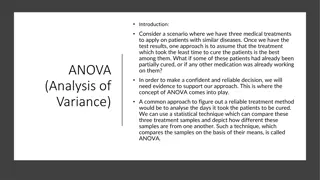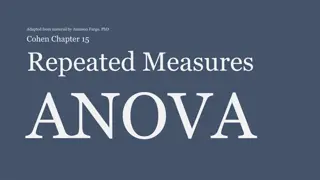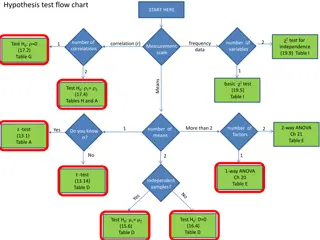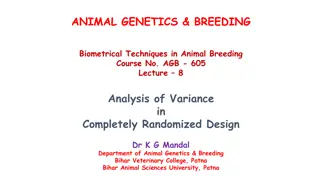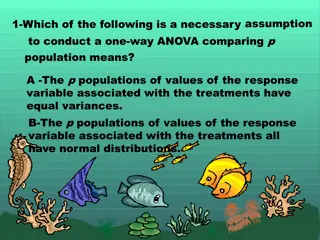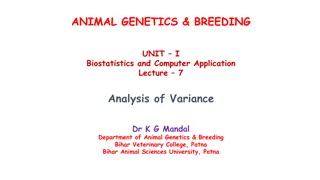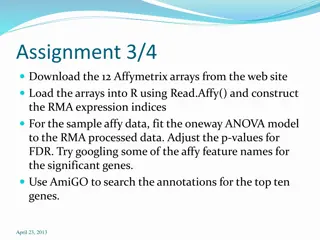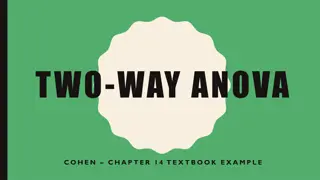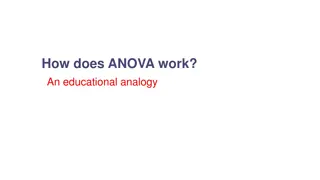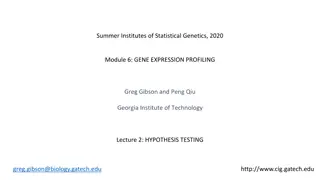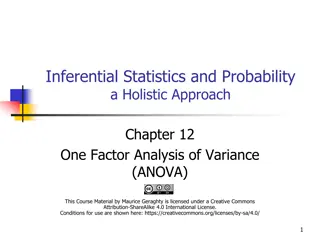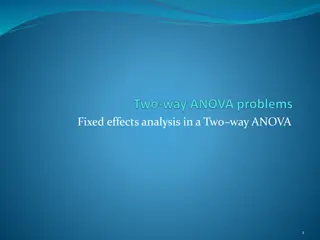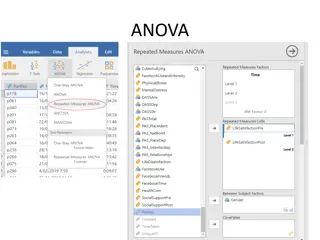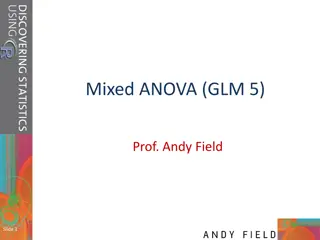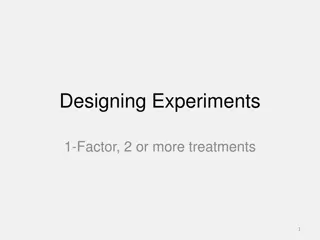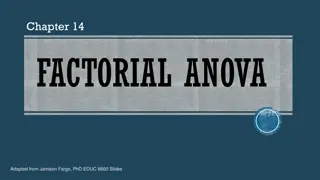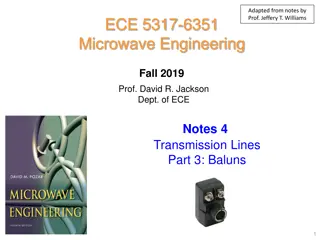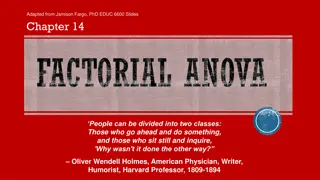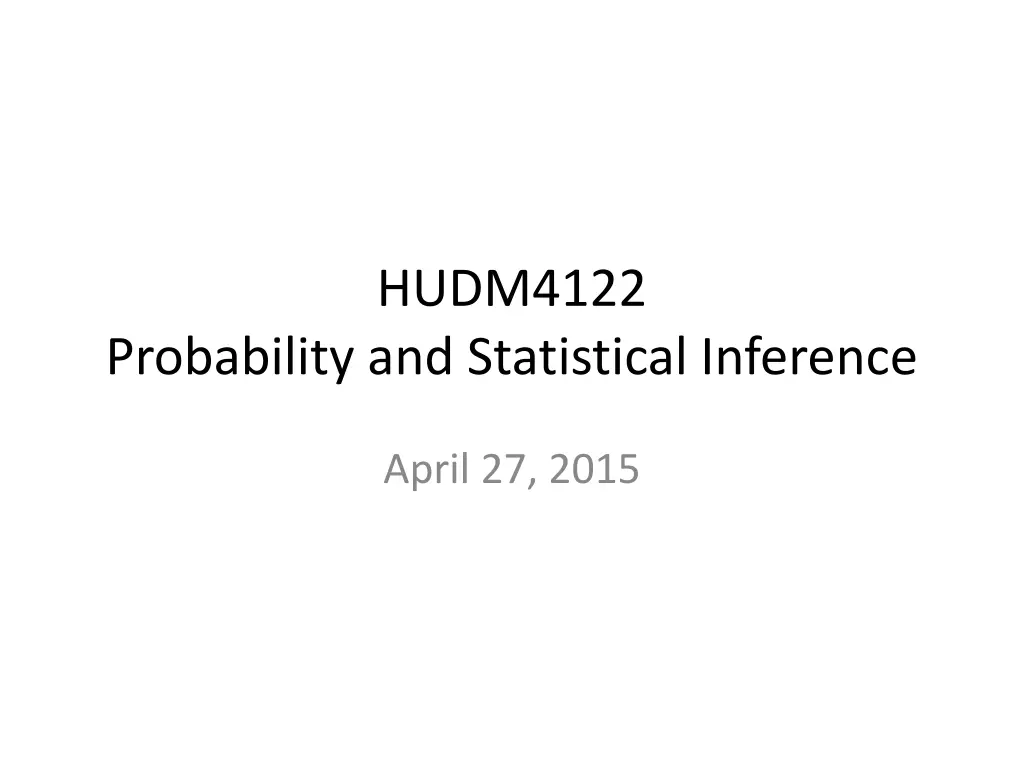
ANOVA Analysis of Variance Overview
Covering the essentials of ANOVA analysis in statistics, this content discusses comparing means across multiple groups and the potential issues with conducting multiple significance tests. It also highlights the importance of post-hoc tests like the Benjamini & Hochberg method. Dive deeper into statistical significance and analysis of variance.
Download Presentation

Please find below an Image/Link to download the presentation.
The content on the website is provided AS IS for your information and personal use only. It may not be sold, licensed, or shared on other websites without obtaining consent from the author. If you encounter any issues during the download, it is possible that the publisher has removed the file from their server.
You are allowed to download the files provided on this website for personal or commercial use, subject to the condition that they are used lawfully. All files are the property of their respective owners.
The content on the website is provided AS IS for your information and personal use only. It may not be sold, licensed, or shared on other websites without obtaining consent from the author.
E N D
Presentation Transcript
HUDM4122 Probability and Statistical Inference April 27, 2015
Given that we ran behind last class I will be compressing the last three lectures a little, and switching order To ensure that we thoroughly cover the most important remaining points
In the remainder of todays lecture We will start our discussion of ANOVA Analysis of Variance
In the previous lecture on We discussed comparing proportions between categorical variables
What if we want to compare several means? Which in its simplest form is One categorical variable One quantitative variable
Like the two-group t-test But more than two groups!
Example The Mt. Vernon City School District is considering 5 science curricula Interactive Science Holt Science Spectrum McDougal Littell Science CK-12 Science Bob s Discount Science Curriculum They randomly divide students into five groups, and each classroom uses one curriculum
You could just Run (5 choose 2)=10 statistical significance tests But there s an issue with that You re running 10 statistical significance tests Which means you have a high chance that one or more will be significant just by chance
And if you just cherry-pick from the set For example, comparing the best curriculum to the worst one You have that same risk, you re just hiding it from yourself
There are valid ways to run several tests They re called post-hoc tests If we have time at the very end of the semester, I will briefly cover one such test, Benjamini & Hochberg If we don t make it there, see Chapter 5, Video 1 in http://www.columbia.edu/~rsb2162/bigdataeducation.html Important note: Many stats courses will teach you to use the Bonferroni procedure, or Tukey s HSD (Ch. 11- 6!), in these situations Not preferred today by most statisticians
Typically what people do is First run an omnibus ANOVA to see if there are any differences between groups at all Then do the post-hoc tests for individual comparisons
Idea behind ANOVA How much variance is there in the data overall? Use that to compute whether there s a difference between groups
Idea behind ANOVA We take the total variation in the data And we divide it into the amount that can be attributed to each factor of interest This can be used for much more complex analyses than just one categorical, one quantitative!
Assumptions of ANOVA There are k groups Your data within each group is normally distributed There is a common variance across groups
ANOVA is not just one test It s an entire family of tests Starting with simple multi-group extensions of two-group t-tests and paired t-tests And going to extensions like MANOVA where you re predicting multiple variables at once
And again The reason to look for overall differences before hunting for individual differences between groups Is to avoid running lots and lots and lots of tests
Single-factor ANOVA One categorical variable One quantitative variable
Single-factor ANOVA H0: All groups have the same mean Ha: At least one group has a mean that is statistically significantly different than the other means
Example Again The Mt. Vernon City School District is considering 5 science curricula Interactive Science Holt Science Spectrum McDougal Littell Science CK-12 Science Bob s Discount Science Curriculum They randomly divide students into five groups, and each classroom uses one curriculum
You have k samples from k populations In this case 5 samples from 5 populations With sample means ?1, ?2, ?3, ?4, ?5 And sample standard deviations are close enough to hypothesize that there is a common Is at least one mean higher or lower than the rest?
What we do Take ???, the j-th data point for the i-th sample And take the overall sample mean, ? In that case, we can assess the total variation in the experiment as the total sum of squares
Total Sum of Squares Can be written two ways ?)2 Total SS = (??? Easier to compute ( ???)2 ? Theoretically useful Total SS = ???2
Total Sum of Squares Is made up of two components The sum of squares for treatments (SST) The sum of squares for errors (SSE) Total SS = SST + SSE
Sum of Squares for Treatments (SST) The variance attributable to the difference between treatments SST = ??( ?? ?)2
Sum of Squares for Errors (SSE) The pooled variation in the k samples SSE = ?1 1 ?12+ ?2 1 ?22+ + ?? 1 ??2
Note Since Total SS = SST + SSE You only need to calculate two of them Although calculating all three can be a good way to check yourself
Once you have Total SS, SST, SSE You can find the degrees of freedom for each And then compute the mean squares Which are used to conduct an ANOVA
Degrees of freedom Degrees of freedom on total SS = (n-1) Degrees of freedom on SST = (k-1) Degrees of freedom on SSE = n-k
Mean squares MSS = TSS/df(TSS) MST = SST/df(SST) MSE = SSE/df(SSE) MSE is a pooled estimate of
Now we can test our null hypothesis H0 : All groups have the same mean Ha : At least one group has a mean that is statistically significantly different than the other means
How do we test it? Well, if H0 is true Then MST = MSE Because the variation between groups will be the same as the variation within all groups
How do we test it? But if H0 is false Then MST > MSE Because the variation between groups will be different than the variation within all groups
So we can compute F = ??? ??? Where F is a new distribution that we haven t seen before
F Distribution From www.epixanalytics.com
F Distribution Is the ratio of two distributions F = (df1)/ (df2)
F Distribution And as such, it has two types of degrees of freedom numerator df denominator df F = (df1)/ (df2)
F distribution Numerator degrees of freedom MST degrees of freedom k-1 Denominator degrees of freedom: MSE degrees of freedom n-k
Finding the p value For a given F value, denominator degrees of freedom df (MST), and numerator degrees of freedom df (MSE) =FDIST(F,df(MST),df(MSE) Written F(df(MST),df(MST))=f, p =
Example: Student Attitudes Interactive Science: 3, 4, 5 Holt Science Spectrum: 5, 5, 4 McDougal Littell Science: 4, 4, 5 CK-12 Science: 3, 3, 4 Bob s Discount Science Curriculum: 1, 1, 2
? = 3.5333 Interactive Science: 3, 4, 5 Holt Science Spectrum: 5, 5, 4 McDougal Littell Science: 4, 4, 5 CK-12 Science: 3, 3, 4 Bob s Discount Science Curriculum: 1, 1, 2
? = 3.5333 Interactive Science: 3, 4, 5: ?1 Holt Science Spectrum: 5, 5, 4: ?2 McDougal Littell Science: 4, 4, 5: ?3 CK-12 Science: 3, 3, 4: ?4 Bob s Discount Science Curriculum: 1, 1, 2: ?5
? = 3.5333 Interactive Science: 3, 4, 5: ?1= 4 Holt Science Spectrum: 5, 5, 4: ?2 = 4.667 McDougal Littell Science: 4, 4, 5: ?3 = 4.333 CK-12 Science: 3, 3, 4: ?4= 3.33 Bob s Discount Science Curriculum: 1, 1, 2: ?5 = 1.33
Total SS = (??? ?)2 Interactive Science: 3, 4, 5: ?1= 4 Holt Science Spectrum: 5, 5, 4: ?2 = 4.667 McDougal Littell Science: 4, 4, 5: ?3 = 4.333 CK-12 Science: 3, 3, 4: ?4= 3.33 Bob s Discount Science Curriculum: 1, 1, 2: ?5 = 1.33
Total SS = (??? ?)2 Interactive Science: 3, 4, 5: ?1= 4 Holt Science Spectrum: 5, 5, 4: ?2 = 4.667 McDougal Littell Science: 4, 4, 5: ?3 = 4.333 CK-12 Science: 3, 3, 4: ?4= 3.33 Bob s Discount Science Curriculum: 1, 1, 2: ?5 = 1.33 (3-3.533)2 + (4-3.533)2 +(5-3.533)2 +(5-3.533)2+(5-3.533)2+(4-3.533)2 + .
Total SS = (??? ?)2= 25.7333 Interactive Science: 3, 4, 5: ?1= 4 Holt Science Spectrum: 5, 5, 4: ?2 = 4.667 McDougal Littell Science: 4, 4, 5: ?3 = 4.333 CK-12 Science: 3, 3, 4: ?4= 3.33 Bob s Discount Science Curriculum: 1, 1, 2: ?5 = 1.33 (3-3.533)2 + (4-3.533)2 +(5-3.533)2 +(5-3.533)2+(5-3.533)2+(4-3.533)2 + .
SST = ??( ?? ?)2 Interactive Science: 3, 4, 5: ?1= 4 Holt Science Spectrum: 5, 5, 4: ?2 = 4.667 McDougal Littell Science: 4, 4, 5: ?3 = 4.333 CK-12 Science: 3, 3, 4: ?4= 3.333 Bob s Discount Science Curriculum: 1, 1, 2: ?5 = 1.333 3(4-3.533)2 + 3(4.667-3.533)2 +3(4.333-3.533)2 +3(3.333-3.533)2+3(1.333-3.533)2
SST = ??( ?? ?)2 = 21.0667 Interactive Science: 3, 4, 5: ?1= 4 Holt Science Spectrum: 5, 5, 4: ?2 = 4.667 McDougal Littell Science: 4, 4, 5: ?3 = 4.333 CK-12 Science: 3, 3, 4: ?4= 3.333 Bob s Discount Science Curriculum: 1, 1, 2: ?5 = 1.333 3(4-3.533)2 + 3(4.667-3.533)2 +3(4.333-3.533)2 +3(3.333-3.533)2+3(1.333-3.533)2

